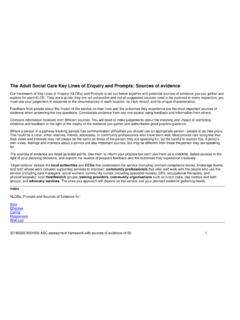Transcription of Quality improvement in hospital trusts
1 Quality improvement in hospital trustsSharing learning from trusts on a journey of QISEPTEMBER 2018 bAbout the Care Quality Commission Our purposeThe Care Quality Commission is the independent regulator of health and adult social care in England. We make sure that health and social care services provide people with safe, effective, compassionate, high- Quality care and we encourage care services to improve. Our roleWe register health and adult social care monitor and inspect services to see whether they are safe, effective, caring, responsive and well-led, and we publish what we find, including Quality use our legal powers to take action where we identify poor speak independently, publishing regional and national views of the major Quality issues in health and social care, and encouraging improvement by highlighting good practice. Our valuesExcellence being a high-performing organisationCaring treating everyone with dignity and respectIntegrity doing the right thingTeamwork learning from each other to be the best we canSHARING LEARNING FROM trusts ON A JOURNEY OF QI Quality improvement IN hospital TRUSTS1 ContentsFOREWORD.
2 2 INTRODUCTION ..3 CLEAR STRATEGIC INTENT FOR QI ..7 leadership FOR QI ..12 BUILDING improvement SKILLS AT ALL LEVELS ..18 BUILDING A CULTURE OF improvement AT ALL LEVELS ..23 PUTTING THE PATIENT AT THE CENTRE OF QI ..29 THE SYSTEM VIEW ..34 CLOSING SUMMARY ..37 FURTHER RESOURCES ..38 REFERENCES ..39 FOREWORD2 ForewordDemand on health and social care services is increasing year-on-year. This increased workload puts Quality of care at risk but, despite these pressures, we have found that hospital trusts that put a focus on continuous Quality improvement have demonstrated that they can deliver high- Quality care. In those trusts we have rated as outstanding, we have found a culture of Quality improvement embedded throughout the our 2017 report, Driving improvement : Case studies from eight NHS trusts , we found that the Quality of leadership is a key influence of the ability of trusts to improve.
3 Leaders needed to be seen to lead, and drive a culture of improvement across the whole organisation. We saw that several trusts on their improvement journey out of special measures or from a rating of inadequate used a Quality improvement (QI) method particularly around safety. This was having a direct impact on the Quality of care for patients and improved outcomes for them for example a reduction in falls and pressure ulcers and improved mortality rates. Where a culture of improvement is driven by the hospital trust s leaders, QI becomes a frontline activity in many trusts , where staff are directly able to listen to patients and implement changes that make a real difference to patient care. We wanted to explore further to hear trusts experiences of QI as a systematic approach to improving service Quality , efficiency and morale not just as a mechanism to problem solve in failing parts of the organisation, but as a way of expanding improvement beyond organisational or functional boundaries, so that impact is possible across the wider health and social care system.
4 QI has been shown to deliver better patient outcomes, and improved operational, organisational and financial performance when led effectively, embedded through an organisation and supported by systems and QI is used well, it gives us confidence about the long-term sustainability of the Quality of care. More informally, when we visit trusts that have an established QI culture, they feel different. Staff are engaged, they are focused on the Quality of patient care, and they are confident in their ability to improve. This is also reflected in surveys of staff and patient would expect that a hospital trust committed to delivering high- Quality care should be embedding a systematic and effective approach to QI. However, we recognise that it is not easy. Rather than a quick fix, this is a challenging endeavour, changing behaviour in complex organisations and developing an effective leadership and organisational culture.
5 We think this report will be particularly valuable to healthcare organisations considering adopting QI, particularly senior leaders committed to delivering sustainable high- Quality care for patients. This report is not a how-to guide , but uses the words of hospital staff and case studies of successful initiatives to share learning about trusts on a journey of QI where curiosity and humility are essential improvement behaviours. We describe what the organisations look like, rather than prescribing how to get there. Professor Ted Baker Chief Inspector of Hospitals TheCarQCulityouomaQCmQstnlCaheQaiTnanSHA RING LEARNING FROM trusts ON A JOURNEY OF QI INTRODUCTION 3 IntroductionThe Care Quality Commission has unique insights from the comprehensive inspection programme of all health and social care providers nationally. Alongside the traditional regulatory role, we were given an additional mandate in the Health and Social Care Act of 2012 to encourage improvement .
6 We have found that the Quality of leadership is a key influence of both the Quality and of the ability to improve in health and care providers. This has been reported in our series of Driving improvement reports, which includes Driving improvement : Case studies from eight NHS We have also evolved our regulatory model to focus more on leadership in the annual trust -wide well-led inspection programme. In some hospitals, there has been a journey of building and embedding a systematic process to improve the Quality of care, usually referred to as Quality improvement (QI). QI has been shown to deliver better patient outcomes alongside improvement in operational, organisational and financial performance, when led effectively, embedded through an organisation, and supported by organisational systems and training. When we visit these organisations, they feel different there is a palpable focus on Quality and patient-centred care, with engaged staff that are enabled to make improvements to the care they State of Care2 report in 2017 found that almost all the trusts rated as outstanding had a clear model for QI across the trust .
7 We also saw leaders who: zwere passionate about the delivery of high- Quality care for patients zwere actively engaged zsought the views of staff and patients zwere committed to organisational development zhad a clear vision and strategy that was understood by staff zmade sure that governance was strong, so that problems were dealt with report focuses on leadership , alongside the behavioural and cultural aspects of hospitals that have built and embedded a process to improve the Quality of care. It aims to share learning from such hospital trusts to inspire and encourage wider improvement in the Quality of care delivered. My advice to anyone thinking about embarking on this journey is to get out and see somewhere where they are already doing this. QI isn t a quick fix go and get a feel for it. Someone who will give you the warts and all version. Sarah Scales, Head of Programme Management Office, Royal Surrey County HospitalThis report is particularly aimed at those in healthcare organisations considering adopting QI as a strategic priority, particularly senior leaders who are committed to delivering sustainable, high- Quality care and looking to develop their organisation with that strategic intent.
8 Importantly, this report is not a how-to guide , but should be taken as a tool to build curiosity and share learning. We are describing what the organisations look like, rather than prescribing how to get 4 What do we mean by Quality improvement (QI)?We have seen significant improvements in Quality of care through our regulatory processes. These improvements are achieved through a variety of means, which can be ad hoc, and not part of an improvement programme or aligned to an organisation s strategy. By contrast, QI is an approach to improving service Quality , efficiency and morale simultaneously: this is done by systematically enabling staff and leaders in the continuous study of improvement of their work, anchored in methodologies and tools from improvement science. Critically, it requires staff, operational managers and senior leaders to work together, with decision making and problem solving happening as close to the issues being experienced as possible.
9 The difference that we see in trusts using a systematic QI approach is the confidence that we are given about the sustainability of the Quality delivered, and the trajectory of ongoing improvement in the Quality of approach has a variety of names (including Continuous improvement and Lean). In this report we refer to any systematic approach to improvement , anchored in improvement science as concept of a QI journey The process of adopting and embedding QI across an organisation was often described by hospital trusts as a journey, with several common elements described (FIGURE 1): zStrategic intent for QI an early process where senior leaders explore and clarify the purpose and define the organisational approach to QI. This is a carefully planned, holistic introduction of QI. It involves rigorously measuring and tracking progress linked to a strategic plan. The approach also involves identifying and sharing quick wins, and engaging opinion leaders around the purpose for QI to win hearts and minds.
10 ZLeadership for QI where the strategic plan to adopt QI is supported by unwavering commitment from senior leaders, who model appropriate improvement -focused leadership behaviours and a visible and hands-on approach to QI. zBuilding improvement skills at all levels, using a systematic framework for building skills, facilitating improvement work and sharing learning. zBuilding a culture of improvement at all levels, which is modelled by the senior team. The approach engages clinical leaders and empowers and enables all staff to make effective and sustainable improvements. zPutting the patient at the centre of QI the QI journey sharpens the focus on delivering high- Quality patient care and aligning improvement activity to outcomes and experience for patients. To deliver this, patients must be involved and enabled as true and equal partners for QI. zApplying systems thinking in QI activity, which results in improvement beyond organisational or functional boundaries, with impact from improvement activity seen across health, social care and wider is important to note that these are not sequential steps the QI journey is not a linear process.














